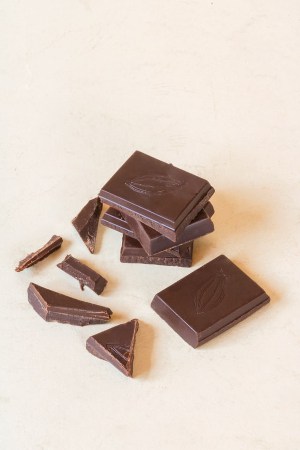With America consuming 2.8 billion pounds of chocolate each year, there is bound to be some form of chocolate or candy in almost every household.
As a responsible pet parent, you must already know to never give your dog chocolate, even a little piece of it. But what if your dog accidentally stumbled on your chocolate stash and helped themselves to a generous amount, your first thoughts will be; should I worry or will they be ok?
But then you notice that they are acting fine; no signs of toxicity and no stomach upset. Why is that, are they not supposed to be sick? These are some of the questions we answer in this article.
Why is chocolate so dangerous?
If my dog has a sweet tooth, why do I have to keep chocolate away from them? Why is chocolate so dangerous to dogs?
Here’s why; chocolate contains a group of organic compounds called methylxanthines (mainly caffeine and theobromine) which a dog’s digestive system cannot properly metabolize. Caffeine and theobromine are stimulants with diuretic properties. Medicinally, these compounds are used as a heart stimulant, smooth muscle relaxant, and to dilate blood vessels.
Unlike the human body, a dog’s body is not able to efficiently metabolize these substances, therefore it’s very sensitive to the effects of these chemicals, especially theobromine. Dogs metabolize theobromine much slower than caffeine, so theobromine stays longer in their system and is majorly responsible for the symptoms of chocolate toxicity.
Is eating a cube of chocolate as dangerous as eating half a bar?
Eating a small cube of chocolate may not be as dangerous as eating half a bar because the level of chocolate toxicity depends on the type of chocolate, the amount that was consumed and the size of the dog.
First, different types of chocolate are toxic to different degrees, generally the darker the chocolate the more toxic it is. And the higher the quantity a dog consumes, the more dangerous it is. And finally, the size of the dog. If a medium or large dog eats a small cube of white or milk chocolate, the dog will be fine. But if a small lap dog consumes the same amount of chocolate, they may show signs of an upset stomach.
A large or medium-sized dog who eats a very small amount of chocolate may not need veterinary treatment, they may not even show any sign of chocolate toxicity. But, you can’t say the same for a small dog. Generally, a small amount of white chocolate rarely poisons a dog, but a small amount of dark chocolate can be very toxic, especially to small dogs.
Why does the size of the dog matter?
Small dogs are more susceptible to chocolate poisoning because theobromine toxicity is dose-related. Despite not being able to properly metabolize theobromine, a dog’s system can tolerate very small amounts of the substance. The toxic dose of theobromine is 20 mg/kg. So, a 50-pound dog who eats 2 ounces of milk chocolate will be fine, but if a 10-pound dog also eats 2 ounces of milk chocolate, expect to observe symptoms like vomiting and diarrhea.
And if a 95-pound dog eats only 2 ounces of baker’s chocolate, they will experience symptoms like vomiting and diarrhea.
The good news is that chocolate toxicity is treatable, and symptoms usually show up within 4 to 12 hours after the chocolate was eaten.
Mild symptoms include vomiting and diarrhea, but extremely high doses of theobromine (think of a 10-pound dog eating 2 ounces of baker’s chocolate) can have life-threatening symptoms such as vomiting, muscles tremors, abnormal heart rhythms, elevated heart rate, hyperthermia, seizures, collapse or even death.
Even as dogs can tolerate small amounts of theobromine, it’s still not advisable to give them even the smallest amount of chocolate. Keep all forms of chocolate away from your pets, because a research study has shown that continuous exposure to theobromine can lead to cardiomyopathy, which is a chronic heart disease that affects the heart muscles, making the heart unable to efficiently pump blood to other parts of the body.
Why is dark chocolate more dangerous than milk chocolate?
If your dog ate chocolate but is acting fine, that’s probably because the amount of chocolate they ate does not contain toxic levels of theobromine for their size. Remember that chocolate toxicity is actually theobromine toxicity, and different types of chocolate contain different amounts of theobromine.
The darker and more bitter the chocolate, the higher the level of theobromine it contains, and the more dangerous it is to dogs. White chocolate rarely poses any threat to dogs because it contains very little amounts of theobromine per ounce; only about 0.25 mg/oz. Milk chocolate contains 44-60 mg of theobromine per ounce, and it can be dangerous depending on the amount consumed and the size of the dogs in question.
Dark semi-sweet chocolate contains 135 mg of theobromine per ounce, and it can be very toxic with severe symptoms. Baker’s chocolate and dry cocoa powder contain very high levels of theobromine (above 400 mg per ounce), they are extremely toxic to dogs and can be lethal.
Is there any way of calculating if I need to take them to the vet?
If you found out that your dog ate some chocolate, you first need to find out the type they ate and the quantity. With the type of chocolate and amount consumed (plus your dog’s size) you can calculate the approximate amount of theobromine that was ingested, and this will give you an idea of what to expect.
If the amount of theobromine is not enough to cause any real harm, then you don’t have to panic. And if they ate an amount that’s enough to cause a negative effect, then you have to monitor them very closely for any signs of stomach upset or discomfort.
If your dog ate a significant amount of chocolate and is showing signs of toxicity, then you need to see a vet as soon as possible. You can use an online chocolate toxicity calculator like this one, to find out the exact amount of theobromine your dog ingested, and what symptoms to expect.
White chocolate is the most dog-friendly chocolate
White chocolate is considered to be the most dog-friendly chocolate because it contains very low levels of theobromine. The almost negligible amount of theobromine in white chocolate makes it almost impossible for dogs (even small dogs) to experience any form of discomfort from consuming it.
Unlike other forms of chocolate, it will take very large amounts of white chocolate for a dog to show signs of theobromine toxicity. However, white chocolate is still not okay for dogs to eat because they contain other ingredients that may pose serious health risks to dogs.
White chocolate contains sugar, milk, cocoa butter, butterfat, etc. All these ingredients are unhealthy for dogs and may cause stomach upset with symptoms like vomiting and diarrhea. These symptoms can be very serious if your dog has a sensitive stomach. And if your dog is prone to pancreatitis, the fats in white chocolate can trigger a painful episode of pancreatitis.
Why else are sweets dangerous for dogs?
Some dogs may have a sweet tooth, sugar (especially refined sugar), should be kept as far away from them as possible. Dogs may be man’s best friend, but they are not like us in many respects.
They do need sugar in the form of carbohydrates, but they shouldn’t eat granulated sugar or any food that contains lots of this type of sugar. Excessive sugar in a dog’s diet poses risk of tooth decay, oral infection, weight gain, obesity, diabetes, arthritis, etc.
Other than sugar and chocolate, there is another form of ‘sweet’ that should be kept very far from dogs; and that is xylitol. Xylitol is a naturally occurring sugar alcohol found in some fruits and vegetables. It used to flavor or sweetener many products including toothpaste, mouth-wash, chewing gums, sugar-free candy, peanut butter, fruit drinks, etc.
While xylitol is completely harmless to humans, it’s extremely toxic to dogs even in very small amounts. Dogs can get hypoglycemia (low blood sugar) from consuming xylitol or products that contain the sugar alcohol. A low dose of xylitol causes hypoglycemia, while higher doses cause liver failure and even death.
My dog ate chocolate but is acting fine
Every responsible pet parent knows the dangers that chocolate poses to their pooch because we’ve been told how damaging those delicious bars can be to dogs. But why is it that your dog is acting fine after eating chocolate?
The answer is simple, your dog did not eat up to the toxic amount of chocolate for them. Chocolate toxicity depends on the amount of theobromine consumed per dog weight. Chocolate bars or drinks with a negligible amount of theobromine may do no harm to dogs.





